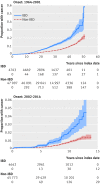Childhood onset inflammatory bowel disease and risk of cancer: a Swedish nationwide cohort study 1964-2014
- PMID: 28931512
- PMCID: PMC5605779
- DOI: 10.1136/bmj.j3951
Childhood onset inflammatory bowel disease and risk of cancer: a Swedish nationwide cohort study 1964-2014
Abstract
Objective To assess risk of cancer in patients with childhood onset inflammatory bowel disease in childhood and adulthood.Design Cohort study with matched general population reference individuals using multivariable Cox regression to estimate hazard ratios.Setting Swedish national patient register (both inpatient and non-primary outpatient care) 1964-2014.Participants Incident cases of childhood onset (<18 years) inflammatory bowel disease (n=9405: ulcerative colitis, n=4648; Crohn's disease, n=3768; unclassified, n=989) compared with 92 870 comparators from the general population matched for sex, age, birth year, and county.Main outcome measures Any cancer and cancer types according to the Swedish Cancer Register.Results During follow-up through adulthood (median age at end of follow-up 27 years), 497 (3.3 per 1000 person years) people with childhood onset inflammatory bowel disease had first cancers, compared with 2256 (1.5 per 1000 person years) in the general population comparators (hazard ratio 2.2, 95% confidence interval 2.0 to 2.5). Hazard ratios for any cancer were 2.6 in ulcerative colitis (2.3 to 3.0) and 1.7 in Crohn's disease (1.5 to 2.1). Patients also had an increased risk of cancer before their 18th birthday (2.7, 1.6 to 4.4; 20 cancers in 9405 patients, 0.6 per1000 person years). Gastrointestinal cancers had the highest relative risks, with a hazard ratio of 18.0 (14.4 to 22.7) corresponding to 202 cancers in patients with inflammatory bowel disease. The increased risk of cancer (before 25th birthday) was similar over time (1964-1989: 1.6, 1.0 to 2.4; 1990-2001: 2.3, 1.5 to 3.3); 2002-06: 2.9, 1.9 to 4.2; 2007-14: 2.2, 1.1 to 4.2).Conclusion Childhood onset inflammatory bowel disease is associated with an increased risk of any cancer, especially gastrointestinal cancers, both in childhood and later in life. The higher risk of cancer has not fallen over time.
Published by the BMJ Publishing Group Limited. For permission to use (where not already granted under a licence) please go to http://group.bmj.com/group/rights-licensing/permissions.
Conflict of interest statement
Competing interests: All authors have completed the Unified Competing Interest form and declare: no support from any organisation for the submitted work; no financial relationships with any organisations that might have an interest in the submitted work in the previous three years, no other relationships or activities that could appear to have influenced the submitted work.
Figures





Comment in
-
Increased risk of cancer in children with inflammatory bowel disease.BMJ. 2017 Sep 20;358:j4285. doi: 10.1136/bmj.j4285. BMJ. 2017. PMID: 28931516 No abstract available.
References
-
- Bernstein CN, Blanchard JF, Kliewer E, Wajda A. Cancer risk in patients with inflammatory bowel disease: a population-based study. Cancer 2001;91:854-62. 10.1002/1097-0142(20010215)91:4<854::AID-CNCR1073>3.0.CO;2-Z pmid:11241255. - DOI - PubMed
-
- Goldacre MJ, Wotton CJ, Yeates D, Seagroatt V, Jewell D. Cancer in patients with ulcerative colitis, Crohn’s disease and coeliac disease: record linkage study. Eur J Gastroenterol Hepatol 2008;20:297-304. 10.1097/MEG.0b013e3282f2a5e2 pmid:18334873. - DOI - PubMed
-
- Beaugerie L, Svrcek M, Seksik P, et al. CESAME Study Group. Risk of colorectal high-grade dysplasia and cancer in a prospective observational cohort of patients with inflammatory bowel disease. Gastroenterology 2013;145:166-175.e8. 10.1053/j.gastro.2013.03.044 pmid:23541909. - DOI - PubMed
-
- Askling J, Dickman PW, Karlén P, et al. Family history as a risk factor for colorectal cancer in inflammatory bowel disease. Gastroenterology 2001;120:1356-62. 10.1053/gast.2001.24052 pmid:11313305. - DOI - PubMed
-
- Soetikno RM, Lin OS, Heidenreich PA, Young HS, Blackstone MO. Increased risk of colorectal neoplasia in patients with primary sclerosing cholangitis and ulcerative colitis: a meta-analysis. Gastrointest Endosc 2002;56:48-54. 10.1067/mge.2002.125367 pmid:12085034. - DOI - PubMed
MeSH terms
LinkOut - more resources
Full Text Sources
Other Literature Sources
Medical
